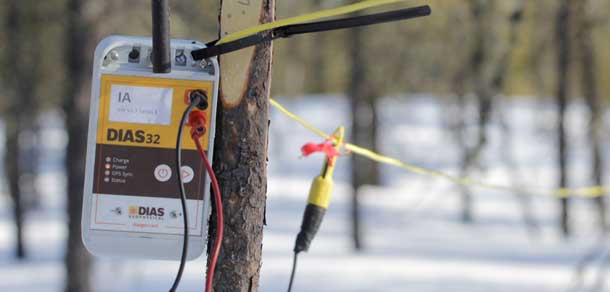DIAS Geophysical Puts the Charge in Surveying
You might think a flying electro-magnetic SQUID is something out of science fiction, but it is actually a (literally) down-to-earth innovation in geophysical surveying.
“The term SQUID stands for Superconducting Quantum Interference Device. That’s an intimidating term and not a lot of people know what it means. But as acronyms go, it sure sounds cool,” says Glenn Chubak, Geoscientist-In-Training, the vice-president of technology at DIAS Geophysical.
Dias specializes in geophysical surveying technologies, in particular its DIAS32 system that Chubak calls the company’s “bread and butter technology.” Dias is active on six continents, with Saskatoon serving as the operational base for all projects. Dias has grown quickly and employs approximately 25 full-time employees and a similar number of field staff who work on a rotating project basis.
Its focus is on research to develop new, safer and more effective technologies. Recently, it has partnered with Supracon AG in Germany to develop a new airborne SQUID system for geophysical surveying.
Getting a Charge Out of Surveying
The DIAS32 system is based on relatively simple and well-known principles of physics and geoscience.
“Different minerals have different levels of electrical conductivity. Systems like DIAS32 send an electrical charge into the earth and then measure the resulting voltage. This allows us to take an educated guess at the minerals below the surface.”
“The technology is not new and we have several competitors. What sets us apart is that our technology is wireless and collects much larger data sets.”
“The ‘big data’ aspect – tens of millions of data points – means our surveys can be much more accurate and cover a larger area. The wireless component means that our system is less costly and safer. Our system involves less than one-sixth of the amount of wiring and equipment of competing systems. Imagine doing a survey in a mountainous area, our system can allow operators to carve back as much as 10 kilograms of equipment weight per station which can make a significant difference for crew safety in treacherous areas.”
The Flying SQUID
With Supracon AG, Dias takes its surveying technology to a new level with the German company’s magnetic-based SQUID system.
“Think of SQUID as the world’s most accurate compass. It measures magnetic patterns under the earth. Geoscientists know minerals formed at the same time have an identical or similar magnetic alignment. If you were exploring for diamonds and you knew other diamonds from that area had a particular magnetic alignment and you detected other minerals in the same area with the same alignment, there’s a better chance that those deposits would also be diamonds.”
Since the magnetic patterns can be detected above the surface, the DIAS32/SQUID system can detect them through airborne surveys, which increases the speed, efficiency and cost-effectiveness of the exploration process.
Struck by Lightning
At a recent Prospectors & Developers Association of Canada meeting, Dias unveiled this new generation of SQUID in an airborne system they have developed with Supracon AG. This system is entirely passive using natural field energy from the sun and distant lightning strikes to investigate potential subsurface mineral deposits.
“Lightning creates an electromagnetic pulse. As that pulse travels, different structures in the Earth cause the pulse to twist and warp. By measuring these distortions, we can find important information about mineral deposits, geologic faults and many other things,” Chubak says.
